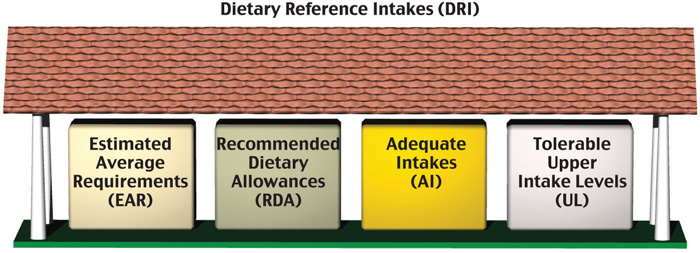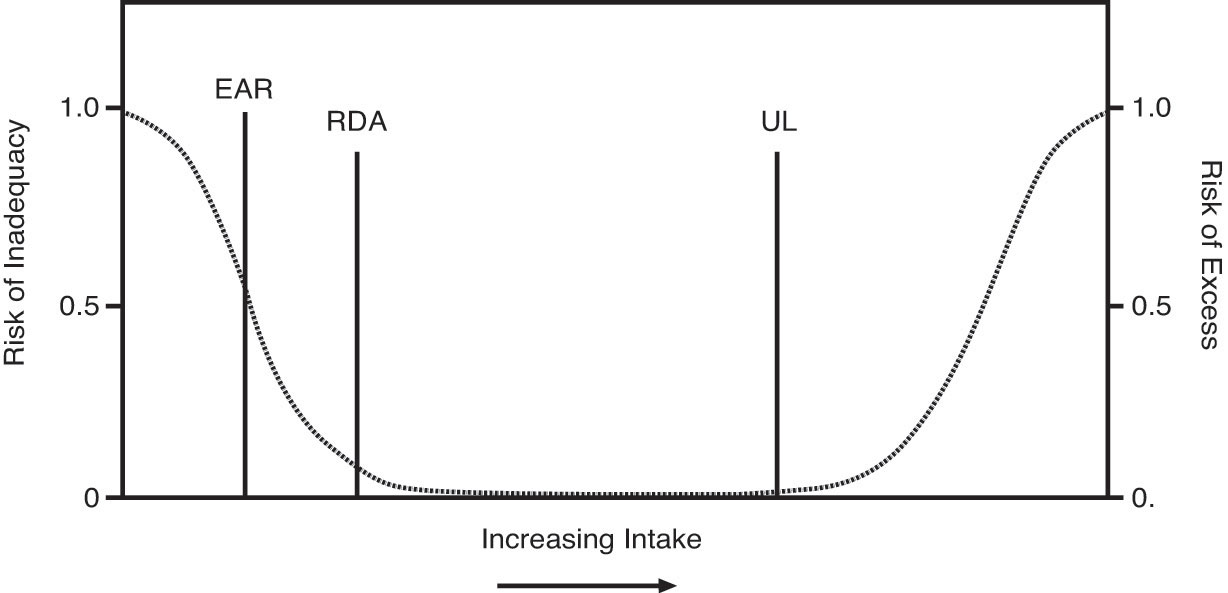what type of studies are used to determine the ear requirement for a nutrient in a given population?
This is "Agreement Daily Reference Intakes", section two.6 from the volume An Introduction to Nutrition (v. 1.0). For details on it (including licensing), click hither.
This book is licensed under a Creative Commons by-nc-sa 3.0 license. Come across the license for more details, simply that basically ways you lot can share this volume equally long every bit yous credit the author (but run into below), don't brand coin from information technology, and practice make information technology available to anybody else under the aforementioned terms.
This content was attainable as of December 29, 2012, and it was downloaded so by Andy Schmitz in an effort to preserve the availability of this book.
Normally, the author and publisher would exist credited here. However, the publisher has asked for the customary Creative Eatables attribution to the original publisher, authors, title, and book URI to exist removed. Additionally, per the publisher'south request, their name has been removed in some passages. More than information is available on this projection'due south attribution page.
For more information on the source of this book, or why it is bachelor for costless, please come across the project's home page. You can scan or download additional books there. To download a .zip file containing this book to use offline, just click hither.
Has this book helped yous? Consider passing it on:

Creative Eatables supports free culture from music to education. Their licenses helped make this book available to you lot.

DonorsChoose.org helps people like you lot assistance teachers fund their classroom projects, from art supplies to books to calculators.
ii.6 Understanding Daily Reference Intakes
Learning Objective
- Use the Dietary Reference Intakes to determine daily nutrient recommendations.
Dietary Reference Intakes (DRI)A set of nutrient recommendations that includes the Estimated Average Requirements (EAR), Recommended Dietary Allowances (RDA), Adequate Intakes (AI), Tolerable Upper Intake Levels (UL) and Adequate Macronutrient Distribution Range (AMDR). are the recommendation levels for specific nutrients and consist of a number of unlike types of recommendations. This DRI system is used in both the Us and Canada.
Daily Reference Intakes: A Brief Overview
"Dietary Reference Intakes" (DRI) is an umbrella term for four reference values:
- Estimated Average Requirements (EAR)Average daily intake levels for nutrients estimated to meet the needs of 50 percent of the target group. Used in diet research and policy-making. EARs form the footing for which RDA values are set.
- Recommended Dietary Allowances (RDA)Based upon the EAR, these are food-intake goals designed to meet the requirements of 97 to 98 percentage of the target group for a given food.
- Acceptable Intakes (AI)If scientific data is insufficient to establish an EAR value, an AI is established based on the scientific data that is available. As with the RDA, the AI serves a nutrient-intake goal.
- Tolerable Upper Intake Levels (UL)The highest average daily nutrient-intake level at which a food can be consumed earlier it poses a gamble of toxicity.
The DRIs are non minimum or maximum nutritional requirements and are not intended to fit everybody. They are to be used as guides only for the majority of the healthy population.Deng, Southward., B. J. Westward, and C. J. Jensen. "A Quantitative Comparison of Phytochemical Components in Global Noni Fruits and Their Commercial Products." Food Chemistry 122, no. 1 (September i, 2010): 267–seventy. http://world wide web.sciencedirect.com/science/article/pii/S0308814610001111.
DRIs are important non simply to assistance the average person decide whether their intake of a particular food is adequate, they are also used past wellness-intendance professionals and policy makers to determine nutritional recommendations for special groups of people who may need aid reaching nutritional goals. This includes people who are participating in programs such as the Special Supplemental Food Program for Women, Infants, and Children. The DRI is not advisable for people who are ill or malnourished, even if they were healthy previously.

The DRIs are inclusive of all four reference values.
© Networkgraphics
Determining Dietary Reference Intakes
Each DRI value is derived in a unlike fashion. See beneath for an explanation of how each is adamant:
- Estimated Average Requirements. The EAR for a nutrient is adamant past a committee of diet experts who review the scientific literature to determine a value that meets the requirements of 50 percent of people in their target group within a given life stage and for a detail sex activity. The requirements of half of the group will fall beneath the EAR and the other half will be above it. Information technology is important to note that, for each nutrient, a specific bodily function is chosen as the criterion on which to base the EAR. For example, the EAR for calcium is set using a criterion of maximizing os health. Thus, the EAR for calcium is prepare at a signal that will meet the needs, with respect to bone wellness, of half of the population. EAR values become the scientific foundation upon which RDA values are set.
- Recommended Daily Allowances. In one case the EAR of a nutrient has been established, the RDA tin exist mathematically determined. While the EAR is set up at a point that meets the needs of one-half the population, RDA values are set to meet the needs of the vast majority (97 to 98 percentage) of the target healthy population. It is of import to note that RDAs are not the same thing every bit private nutritional requirements. The actual nutrient needs of a given individual will exist unlike than the RDA. Yet, since nosotros know that 97 to 98 percent of the population's needs are met by the RDA, we can presume that if a person is consuming the RDA of a given food, they are most probable meeting their nutritional demand for that nutrient. The important thing to recall is that the RDA is meant as a recommendation and meeting the RDA means it is very likely that y'all are meeting your actual requirement for that nutrient.
Understanding the Departure
There is a distinct difference betwixt a requirement and a recommendation. For instance, the DRI for vitamin D is a recommended 600 international units each day. All the same, in order to find out your true personal requirements for vitamin D, a blood test is necessary. The blood test will provide an accurate reading from which a medical professional can guess your required daily vitamin D amounts. This may be considerably more or less than the DRI, depending on what your level actually is.
- Adequate Intake. AIs are created for nutrients when there is bereft consequent scientific evidence to set an EAR for the unabridged population. As with RDAs, AIs can exist used as nutrient-intake goals for a given nutrient. For instance, there has not been sufficient scientific research into the particular nutritional requirements for infants. Consequently, all of the DRI values for infants are AIs derived from nutrient values in man chest milk. For older babies and children, AI values are derived from human milk coupled with data on adults. The AI is meant for a salubrious target group and is not meant to exist sufficient for certain at-chance groups, such as premature infants.
- Tolerable Upper Intake Levels. The UL was established to help distinguish healthful and harmful nutrient intakes. Developed in part as a response to the growing usage of dietary supplements, ULs indicate the highest level of continuous intake of a particular food that may exist taken without causing wellness problems. When a nutrient does not have whatever known issue if taken in excessive doses, information technology is not assigned a UL. Still, even when a food does non have a UL it is not necessarily prophylactic to consume in big amounts.
Figure 2.1 DRI Graph

This graph illustrates the risks of nutrient inadequacy and nutrient excess every bit we move from a low intake of a nutrient to a loftier intake. Starting on the left side of the graph, yous can encounter that when you have a very depression intake of a nutrient, your gamble of nutrient deficiency is loftier. Equally your nutrient intake increases, the chances that you will be deficient in that nutrient subtract. The point at which 50 percent of the population meets their nutrient need is the EAR, and the point at which 97 to 98 percent of the population meets their needs is the RDA. The UL is the highest level at which you can consume a nutrient without information technology being too much—as nutrient intake increases beyond the UL, the hazard of wellness problems resulting from that nutrient increases.
Source: Constitute of Medicine. © 2012 National Academy of Sciences. All Rights Reserved. http://www.iom.edu.
- Acceptable Macronutrient Distribution Ranges. The Acceptable Macronutrient Distribution Range (AMDR)The value of the free energy-yielding nutrients carbohydrates, protein, and fat, expressed as percentages of full daily calorie intake, sufficient to provide total adequate free energy needs; staying within the AMDR is associated with reducing the risks for developing chronic illness. is the calculated range of how much energy from carbohydrates, fats, and protein is recommended for a healthy diet. People who do not attain the AMDRs for their target group increase their risk of developing health complications. See Affiliate 10 "Nutrients Important for Metabolism and Blood Function" for more information on computing requirements.
Table ii.7 AMDR Values for Adults
| Nutrient | Value (percentage of Calories) |
|---|---|
| Fatty | twenty.0–35.0 |
| Carbohydrate | 45.0–65.0 |
| Protein | 10.0–35.0 |
| Polyunsaturated fatty acids | 5.0–10.0 |
| Linolenic acid | 0.6–1.2 |
Source: Nutrient and Nutrition Board of the Institute of Medicine. Dietary Reference Intakes for Free energy, Saccharide, Fiber, Fat, Fatty Acids, Cholesterol, Protein, and Amino Acids. (Washington, DC: National Academies Press, 2002).
Tips for Using the Dietary Reference Intakes to Plan Your Diet
You can employ the DRIs to help appraise and plan your nutrition. Go on in heed when evaluating your nutritional intake that the values established have been devised with an ample safety margin and should exist used equally guidance for optimal intakes. Also, the values are meant to assess and plan average intake over time; that is, you lot don't demand to meet these recommendations every unmarried day—meeting them on average over several days is sufficient.
Cardinal Takeaways
- Nutrient-intake recommendations ready for healthy people living in the United States and Canada are known as Dietary Reference Intakes.
- The DRIs includes the AI, EAR, RDA, and UL for micronutrients and the AMDR ranges for energy-yielding macronutrients. The DRI provide a prepare of standards for researchers and government policy-makers, and specifies nutrient consumption guidelines for individuals.
Discussion Starter
- Why do you think information technology is of import for the government to set the DRI standards? How will y'all use this information for your personal dietary choices?
Source: https://2012books.lardbucket.org/books/an-introduction-to-nutrition/s06-06-understanding-daily-reference-.html
0 Response to "what type of studies are used to determine the ear requirement for a nutrient in a given population?"
Post a Comment